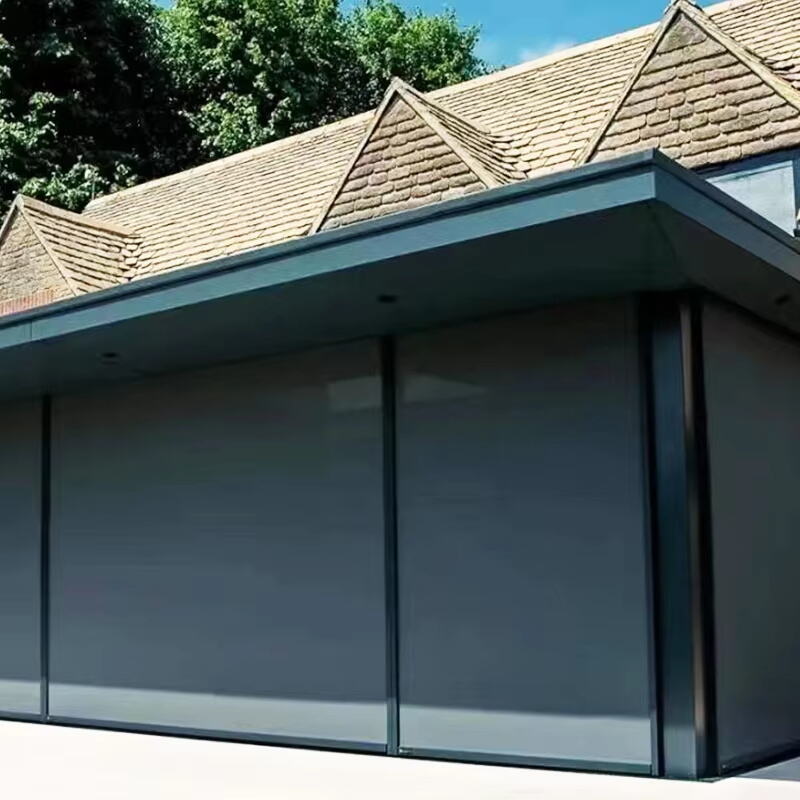Ablakdíszítés modernizálása: a redőnytechnológia fejlődése
Az ablakdíszítések világa az utóbbi években meglepő átalakuláson ment keresztül, az elektromos áttekintő újításként bontakozik ki az otthon automatizálás terén. Mivel az otthonok egyre inkább a kényelem és a stílus kombinálását célozzák, az elektromos és hagyományos kézi redőnyök közötti választás egyre fontosabb szemponttá vált a belső tértervezés és otthonfejlesztési döntések során. Ez az átfogó útmutató a két opció közötti főbb különbségeket, előnyöket és szempontokat ismerteti, hogy segítsen meghozni a megfelelő döntést az Ön életterében.
Az elektromos redőnyrendszerek megértése
Alapvető összetevők és funkciók
Elektromos áttekintő a nyílászárók kezelésének technológiai csúcsát képviselik, amelyek motorokat, vezérlőrendszereket és okosotthon integrációs képességeket tartalmaznak. Ezek a rendszerek általában egy motorizált egységből állnak, amely vezérli a redőny mozgását, egy energiaforrásból (vagy vezetékes, vagy akkumulátoros), valamint különféle vezérlési lehetőségekből, egyszerű távirányítótól a kifinomult okosotthon rendszerekig. A motorokat úgy tervezték, hogy simán és csendben működjenek, biztosítva a mindennapi tevékenységek minimális zavarását.
A modern elektromos redőnyöket programozni lehet ütemezés szerint működésre, környezeti tényezőkre való reagálásra, illetve távirányításuk lehet bárhonnan okostelefonos alkalmazásokon keresztül. Ez a fokú automatizálás nemcsak kényelmet nyújt, hanem hozzájárul a háztartás energiahatékonyabb kezeléséhez is.
Telepítési és karbantartási követelmények
Az elektromos redőnyök telepítése általában szakértelmet igényel, különösen a vezetékes rendszereknél, amelyeket a ház villamos hálózatába kell integrálni. Az akkumulátorral működő megoldások rugalmasabb telepítést biztosítanak, de időszakos akkumulátorcsere szükséges. A rendszeres karbantartás magában foglalja a mechanizmusok tisztán tartását, a megfelelő pozíció ellenőrzését, valamint a motor és vezérlőrendszerek helyes működésének biztosítását.
Bár a kezdeti beállítás összetettebb lehet, mint a manuális redőnyök esetében, a hosszú távú karbantartási igények gyakran hasonlóak, azzal a plusz előnnyel, hogy a mechanikus alkatrészek kopása csökken a folyamatos, szabályozott működésnek köszönhetően.

A kézi működtetésű redőnyök hagyományos vonzereje
Egyszerűség és megbízhatóság
A kézi működtetésű redőnyök időt álló megoldást kínálnak az ablakok árnyékolására, egyszerű és megbízható mechanikus kialakítással. Ezek működése általában egy csigasoros rendszeren vagy egy kézi kar segítségével történik, amely lehetővé teszi a redőny közvetlen beállítását. Ez az egyszerűség kevesebb meghibásodási lehetőséget és általában alacsonyabb karbantartási igényt eredményez.
A kézi működtetés tapintható jellege teljes kontrollt biztosít a felhasználó számára a redőny pontos pozíciójának beállításában, amit egyes tulajdonosok az automatikus rendszerekkel szemben részesítenek előnyben. Emellett az elektromos alkatrészek hiánya miatt ezek a redőnyök áramszünet esetén is működőképesek maradnak.
Költség szempontjai és elérhetőség
A kézi működtetésű árnyékolók egyik legnagyobb előnye az alacsonyabb kezdeti költségük az elektromos megoldásokhoz képest. Az egyszerűbb szerkezet és a telepítési folyamat általában olcsóbb vásárlási és beüzemelési költségeket eredményez. Emellett a pótalkatrészek könnyen beszerezhetők, és általában olcsóbbak, mint a motoros megfelelőik.
A kézi működtetésű árnyékolók egyetemes hozzáférhetőséget is biztosítanak, mivel működtetésükhöz nem szükséges technikai ismeret vagy beállítás. Ugyanakkor nehezebb lehet használniuk azoknak az embereknek, akik mozgásukban korlátozottak, illetve olyan ablakoknál, amelyeket nehezen lehet elérni.
Jellemzők és előnyök összehasonlító elemzése
Energiatakarékosság és fényvezérlés
Az elektromos redőnyök kiváló energiahatékonyságot kínálnak automata ütemezés és fényérzékelő funkció révén. Ezeket programozni lehet úgy, hogy a nap során alkalmazkodjanak, optimalizálva a természetes fényhasznosítást és csökkentve a fűtési és hűtési költségeket. A motoros rendszerek által kínált pontos vezérlés lehetővé teszi több ablak esetén is az egységes pozícionálást, maximalizálva az energia-megtakarítási potenciált.
Bár a manuális redőnyök is elérhetnek hasonló fényvezérlési eredményeket, az automatizálás kényelme gyakran vezet az energiatakarékos funkciók összefüggőbb használatához. A több elektromos redőny egyidejű állítási lehetősége szintén biztosítja az egységes fényeloszlást az Ön terein.
Kényelmi és Biztonsági Jellemzők
Az elektromos redőnyök kényelme messze meghaladja az alapvető működést. Olyan fejlett funkciók, mint a hangvezérlés, okostelefonos integráció és automatizált ütemezés jelentősen javíthatják a mindennapi élet minőségét. Ezek a rendszerek integrálhatók a biztonsági rendszerekkel is, így távollétükben is úgy tűnhet, mintha otthon lennének, például a redőnyök automatikus mozgatásával.
A biztonság szintén nagyon fontos szempont, különösen olyan otthonokban, ahol kisgyermekek vagy háziállatok vannak. Az elektromos redőnyök elkerülhetővé teszik a potenciálisan veszélyes zsinórok és láncok használatát, miközben sima, kontrollált működést kínálnak, csökkentve a redőnyök kopását.
A megfelelő döntés saját otthonához
Életmódbeli szempontok
Az elektromos és manuális redőnyök közötti választáskor fontos figyelembe venni a mindennapi rutinfeladatokat és az életmódbeli igényeket. Az elektromos redőnyök kiválóan alkalmasak olyan otthonokba, ahol az automatizálás és a kényelem elsődleges szempont, illetve ahol az ablakok száma nagy vagy nehezen elérhető helyen vannak. Különösen értékesek idős vagy mozgásukban korlátozott személyek számára, akiknek nehézséget okozhat a manuális kezelés.
A manuális redőnyök inkább azoknak felelhetnek meg, akik az egyszerűséget részesítik előnyben, költségkímélés a cél, vagy egy hagyományosabb otthoni megjelenést tartanak fontosnak. Ezek a redőnyök praktikus választásnak számíthatnak olyan helyiségekben is, ahol az automatikus funkciók feleslegesek lehetnek, vagy ahol a közvetlen kezelés előnyösebb.
Hosszú távú értékbecslés
Bár az elektromos redőnyök nagyobb kezdeti beruházást igényelnek, hosszú távon gyakran nagyobb értéket képviselnek az energia-megtakarítás, a ház értékének növekedése és a javított funkciók révén. Az okosotthon rendszerekkel való integráció növelheti az ingatlan vonzerejét a jövőbeli vásárlók szemében, és hozzájárulhat egy modern, hatékony életkörnyezet kialakításához.
A kézi működtetésű redőnyök ugyan olcsóbban vásárolhatók meg, de karbantartás szempontjából igényesebbek lehetnek, mivel a rendszeres használat során gyorsabban kopnak. Ugyanakkor egyszerűbb szerkezetüknek köszönhetően a javításuk általában olcsóbban megoldható.
Gyakran Ismételt Kérdések
Mennyi ideig tartanak általában az elektromos redőnyök?
Az elektromos redőnyök megfelelő karbantartás mellett általában 7-10 évig tartanak, bár a motor élettartama elérheti a 15-20 évet is. Az akkumulátorral működő rendszerek esetében az akkumulátorokat 6-12 havonta cserélni kell a használat gyakoriságától függően.
Lehet-e kézi működtetéssel használni az elektromos redőnyöket szükség esetén?
A modern elektromos redőnyök közül sok rendelkezik kézi vészkioldó funkcióval, amely lehetővé teszi a működtetést áramkimaradás vagy rendszerhiba esetén. Ugyanakkor ez a funkció gyártónként és modell alapján eltérhet, ezért fontos meggyőződni róla a vásárláskor.
Mi az átlagos árkülönbség az elektromos és a kézi működtetésű redőnyök között?
Az elektromos redőnyök ára általában 2-3-szorosa a hasonló kézi redőnyök árának, a költség a mérettől, anyagtól és funkcióktól függ. Ugyanakkor ezt az árkülönbséget össze kell mérni a kényelemmel, az energia megtakarítással és azzal, hogy növelheti az ingatlan értékét.
Nehéz karbantartani az elektromos redőnyöket?
Az elektromos redőnyök tisztítása hasonló igénybevételt jelent, mint a kézi redőnyöké, de időnként szükség lehet az akkumulátor cseréjére vagy a motorrendszer szakértői karbantartására. Számos gyártó garanciát és karbantartási szolgáltatásokat kínál a hosszú távú megbízhatóság érdekében.

